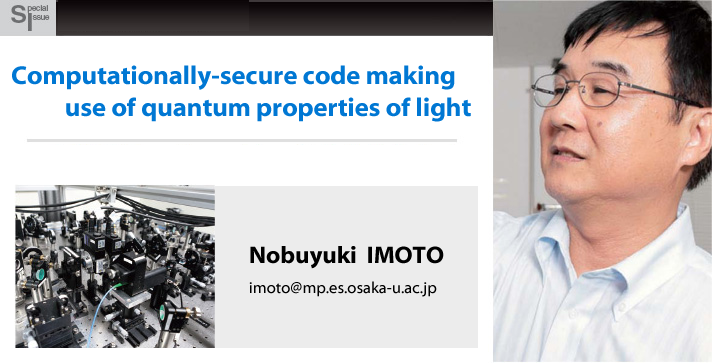
Making computationally-secure code making use of the quantum properties of light
Wavelength conversion technology, essential for long-distance communication, completed
Professor Nobuyuki IMOTO is engaged in research into quantum information processing, a practical application of quantum computers possessing information processing ability that far exceeds that of conventional information processing. Most importantly, the early realization of quantum cryptography communications is anticipated as an totally secure communication tool. Aiming to achieve totally secure long-distance communications, a group of researchers under the leadership of Professor Imoto has perfected wavelength conversion technology and quantum noise reduction technology enabling the transmission of secure quantum information, drawing attention from the world.
Quantum computers are capable of breaking traditional codes
Why is quantum cryptography being eagerly anticipated?
In the pursuit of the possibility of applying quantum mechanical theory to engineering, in 1984, IBM proposed the idea of quantum cryptography. Although it did not attract attention at that time, 10 years later, Bell Laboratories in the USA mathematically proved that quantum computers could accomplish complex information processing in a relatively short time, which meant existing codes (public-key encryption) could be decoded.
In the public-key encryption commonly used now, breaking codes is thought of as impossible because it takes an astronomical amount of time for existing computers to factorize prime numbers in big numbers. On the other hand, quantum computers are able to factorize large numbers as prime numbers and are good at breaking such types of codes.
This fact has created a major headache because this means that quantum computers would be capable of deciphering even the top secrets of a nation.
Light behaves as both a wave and particle
Did the publication by Bell Laboratories make researchers review the value of quantum cryptography?
In 1997, it was proven that quantum cryptography could not be broken even by quantum computers, a finding which has accelerated research toward the practical use of quantum cryptography technology. Quantum cryptography has succeeded in short-distance experiments; however, the key to its practical use is engineering progress enabling quantum communication between distant locations. In quantum cryptography, even eavesdropping itself becomes impossible. An eavesdropper attempting to "listen in" will be detected by the sender and/or receiver. This is because quantum cryptography makes use of the quantum nature of light by being both a wave and particle.
What is the property of quantum?
Quantum's wave-like properties can be seen in the interference wave in a double-slit experiment. However, like electricity, light behaves as both particles and as a wave. When one attempts to observe light with a detector, light behaves as particles. When it's not observed, it behaves as a wave. That means the photon has particle/wave duality. The same can be said for electrons in electricity; they possess particle/wave duality.

"Behavior" of light changes when observed
How can the properties of light be used in quantum cryptography?
Quantum cryptography information cannot be stolen because it uses the principle that "Properties of light change when observed." In quantum cryptography communication, at first, quantum random digits to break a code are sent to a receiver. If information is observed, a deformation in the light during transmission takes place. So the sender and receiver of the information is aware that it has been compromised. If it is found that even a portion of the information was observed, new random digits can be sent. In this way, encrypted information can be transmitted without its being decoded.

Last year you announced wavelength conversion technology leading to the possible realization of long-distance quantum cryptography communication, didn't you?
Currently a large amount of information is transmitted by optical fiber communication. However, the performance of optical fiber communication systems falls to one-half every 15 km. This attenuation problem was resolved by "repeaters" for converting the received light into electric signals and strengthening them for sending again. This method, however, is not good for quantum communication because if light is changed into electric signals, the light's original properties cannot be preserved. In order to solve this problem, quantum repeater technology using quantum teleportation is needed. This technology enables quantum communication without the conversion into electric signals.
Using Quantum teleportation
What is a quantum teleportation?
This technology uses a property of quantum, "quantum entanglement." When one of a set of light in a state of quantum entanglement is hit by another light, the information possessed by the light is transmitted to the other light in another location, i.e., "quantum teleportation" takes place. We succeeded in quantum teleportation experiment in noisy environment. For wavelength conversion for optical fiber wavelength, we used artificial PPLN (Periodically Poled Lithium Niobate) as an wevelength conversion device to reduce noise, thereby succeeding in converting wavelength without changing quantum properties.These technologies will be essential for long-distance quantum information communication.
What is it about physics that gives you pleasure?
The physicist's job is prove methods for realizing things that have been proven mathematically possible. Thinking of the realization in a real situation may lead to new developments in related mathematics and things thought to be unrelated are often found to be related, expanding the horizon of general theory. That is the real joy of phyisics.
In quantum information processing, there are many technologies whose possibilities have been mathematically proven. Undonditionally secure communication of private information by quantum cryptography is a technology that is physically possible and we are really looking forward to its realization.